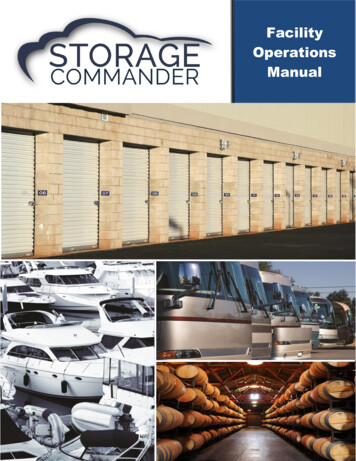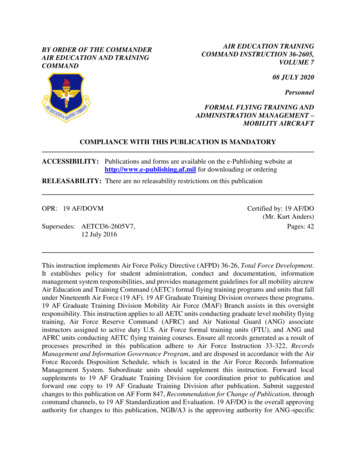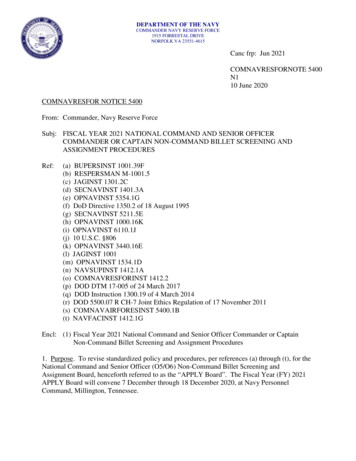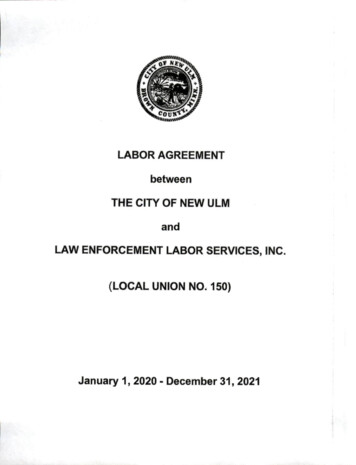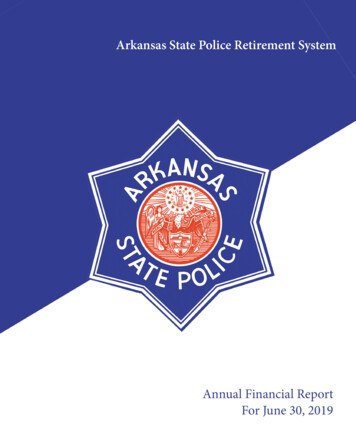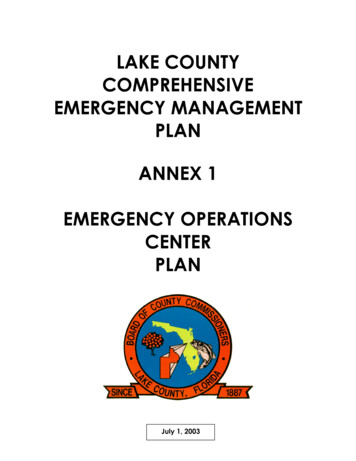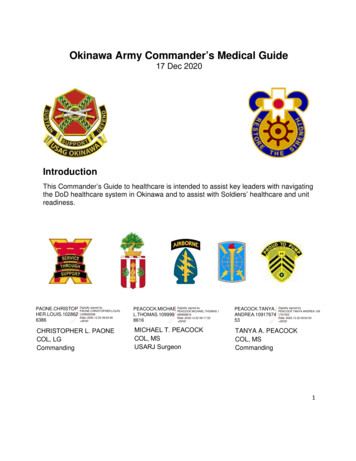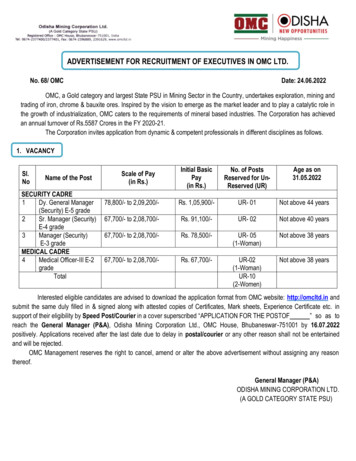
Transcription
BY ORDER OF THE COMMANDERKIRTLAND AIR FORCE BASEAIR FORCE INSTRUCTION 21-101AIR FORCE GLOBAL STRIKE COMMANDSupplementKIRTLAND AIR FORCE BASESupplement4 NOVEMBER 2021MaintenanceAIRCRAFT AND EQUIPMENTMAINTENANCE MANAGEMENTCOMPLIANCE WITH THIS PUBLICATION IS MANDATORYACCESSIBILITY: Publications and forms are available for downloading or ordering on the ePublishing web site at www.e-Publishing.af.milRELEASABILITY: There are no releasability restrictions on the publication.OPR: 377 MXG/MXQSupersedes:AFI21-101 AFGSCSUPKIRTLANDAFBSUP,4 October 2016Certified by: 377 MXG/CC(Col Christopher P. Graves)Pages: 17This publication supplements Air Force Instruction (AFI) 21-101, Aircraft and EquipmentMaintenance Management, and AFI 21-101 AFGSCSUP, Aircraft and Equipment Maintenance,and is supplemented as follows. It provides additional guidance for implementing and maintainingall logistical responsibilities described in AFI 21-101. It applies to the 377th Air Base Wing (377ABW) and associate units that perform maintenance on aircraft or munitions and/or operate on ornear the flightline. Units assigned to the 58th Special Operations Wing (58 SOW), Air ForceResearch Lab, Air Force Reserve Command, and Air National Guard are exempt from thissupplement. Refer recommended changes and questions about this publication to the Office ofPrimary Responsibility (OPR) using Air Force (AF) Form 847, Recommendation for Change ofPublication. Route AF Forms 847s from the field through the appropriate functional's chain ofcommand. Ensure that all records created as a result of processes prescribed in this publicationare maintained in accordance with (IAW) AFI33-322, Records Management and InformationGovernance Program, and disposed of IAW Air Force Records Information Management System(AFRIMS) Records Disposition Schedule (RDS). This publication may not be supplemented or
2AFI21-101 AFGSCSUP KIRTLANDAFBSUP 4 NOVEMBER 2021further implemented/extended. Requests for waivers must be coordinated through the OPR of thissupplement.SUMMARY OF CHANGESThis document has been substantially revised and must be completely reviewed in its entirety.This revision aligns this supplement to the Air Force and Major Command GuidanceMemorandums and Supplements. This revision also supports the 2017 Air Force DirectivePublications Reduction Initiative.
AFI21-101 AFGSCSUP KIRTLANDAFBSUP 4 NOVEMBER 202132.4. Maintenance Group Commander (MXG/CC) Responsibilities. In addition to theresponsibilities listed below, the MXG/CC or equivalent must ensure compliance with themaintenance requirements and programs in Chapter 11 of this instruction. (T-1). Approvedvariations in the MXG organization does not relieve the MXG/CC of compliance with all therequirements of this AFI. (T-1). The 377 MXG is responsible for the following areas: Munitions,Precision Measurement Equipment Laboratory (PMEL), Airfield Operations, Weather, andTransient Aircraft Alert Services (TAAS). The MXG/CC (or equivalent) will:2.4.2.1. (Added) The 377 MXG Quality Assurance (QA) Superintendent (SUPT) will be thegroup Environmental, Safety, and Occupational Health (ESOH) focal point and will be the MXGliaison to 377 ABW Safety Office.2.4.5.1. (Added) Ensure severe weather procedures are followed IAW KIRTLANDAFBI 15101, Weather Support.2.4.9. (Added) The 898th Munitions Squadron (898 MUNS) Unit Training Manager (UTM) willperform duties as the MXG Training Manager. The Training Manager will ensure all squadronsupervisors are meeting their responsibilities regarding upgrade training of enlisted personnel.2.4.11.1. (Added) For transient aircraft related issues contact the Functional Director at DSN:246-7934 or the QA Evaluator at DSN: 246-6898.2.4.43.1. (Added) Impoundment procedures for transient aircraft handled by the 377thMaintenance Squadron (377 MXS) TAAS will be outlined in Chapter 7 of this supplement.2.4.48.1. (Added) 377 ABW does not have assigned Ground Instructional Training Aircraft(GITA) or Training Aircraft Aids (TAA).2.4.52.1. (Added) Assigned units will contact the 377 MXG Technical Order Distribution Office(TODO) to request additional eTools in addition to eTools identified in the 377 MXG MaintenanceStandardization and Evaluation Plan (MSEP).2.4.57.1. (Added) All 377 MXG newsletters, crosstalk information and local/HHQ policyannouncements can be located at the following 377 MXG SharePoint Read%20Files/Forms/AllItems.aspx2.4.60.1. (Added) 377 MXG weekly conducts "MXG Standup" in conjunction with 377ABW/CC. Meeting topics include, munitions production, maintenance schedule shortfalls anddeviations. Minimum attendees include MUNS supervision, Operations Officer/MaintenanceSuperintendent and Quality Assurance.2.4.64.1. (Added) To the maximum extent possible, personnel selected for QA positions willhave a minimum of 6 months Time on Station (TOS). There are no Mission Design Series (MDS)experience requirements. Exception: No TOS requirement for personnel selected as augmentees.(T-3).2.5.1.14. (Added) PMEL production.2.5.1.15. (Added) Munitions Flight production and delivery activities.2.5.1.16. (Added) Airfield status and impact to 377 ABW and 58 SOW activities.2.5.1.17. (Added) Transient aircraft activities, current and upcoming.2.5.1.18. (Added) Weather and related impacts to base mission.
4AFI21-101 AFGSCSUP KIRTLANDAFBSUP 4 NOVEMBER 20212.5.1.19. (Added) 898 MUNS-related production data, logistics missions, and readiness status.4.1. The 377 MXS is a non-standard organization consisting of the following flights: Munitions,PMEL, and Airfield Operations. The Airfield Operations Flight is organized into the AirfieldManagement (AM), Weather and TAAS Sections, with the TAAS mission being executed bycontract. The Munitions Flight will have its own Munitions Accountable Systems Officer(MASO). Additionally, the 377 MXS does not perform aircraft maintenance. Aircraft specificresponsibilities listed in AFI 21-101 are not applicable. AM and Weather responsibilities, whichare normally performed by an Operations Support Squadron, are performed by 377 MXS.4.10.1. (Added) Coordinate with the 58 SOW, Plans and Scheduling Section, forflying/maintenance schedule requirements.4.14. (Added) AirfieldOperationsFlight. AlbuquerqueInternationalSunport(KABQ)/Kirtland Air Force Base (KAFB) is a shared use airport. KABQ is responsible forrunways and all taxiways except Taxiway H (Hotel). The Federal Aviation Administration (FAA)controls the airspace and movement on runways, taxiways, and helipads.4.14.1. (Added) Airfield Management Operations (AMOPS) is the focal point for all operationson the following military areas: ramps A through E; pads 2 through 5; and taxiway H. Agenciesrequesting use of parking aprons or pads for exercises, training, painting, fuel cell operations, etc.,will coordinate with AMOPS at 846-8335/6 at least 48 hours in advance to allow Notices toAirman (NOTAMs) processing, de-confliction and coordination with numerous base agencies.For short-notice requirements, agencies will contact AMOPS to request ramp space use as soon aspossible.4.14.2. (Added) The 377 MXS, Weather Flight, provides weather services to the 377 ABW, 58SOW, and other units assigned or deployed to KAFB, New Mexico. All supported units shallcoordinate with the Weather Flight to either change or request support. When necessary duringProtection Level 1 activities outside during non-duty hours, 377 MXS will schedule/provide aPoint of Contact (POC) at the weather flight to liaise with 898 MUNS Munitions Control.KIRTLANDAFBI 15-101 further describes the capabilities and utilization of the Weather Flight.4.14.3. (Added) TAAS is contracted and is responsible for providing arrival, processing, anddeparture services for transient aircraft. They are also responsible for recovery operations oftransient aircraft that have a disabled wheel utilizing disabled wheel dollies.6.3.23. (Added) Prior to designation of Chief Inspector and Evaluators, conduct an interview toensure personnel have proper experience and professionalism.6.4.7. Review all discrepancies for trends quarterly.6.4.13. 377 MXG QA SUPT or Chief Inspector will conduct all Evaluator Proficiency Evaluations(EPEs).6.7.2.10. (Added) 377 MXG QA SUPT will publish and distribute the quarterly MSEP planapproved by the 377 MXG/CC, which will also include the Routine Inspection List (RIL), KeyTask Listing (KTL), and Acceptable Quality Level (AQL) for all tasks evaluated. 377 orms/AllItems.aspx?viewpath .aspx
AFI21-101 AFGSCSUP KIRTLANDAFBSUP 4 NOVEMBER 202156.7.3.1.1. (Added) Include the E&I plan in the quarterly 377 MXG MSEP.6.7.3.3.1.1. (Added) Consider historical Personnel Evaluations (PEs), Quality VerificationInspection (QVIs), and other inspections data (especially any items having a pass rate of less than80 percent); trends, suspected training deficiencies, Tech Data Violation (TDVs), and DetectedSafety Violation (DSVs).6.7.3.3.3.1. (Added) Identify the assessment type and minimum number of PEs, QVIs, andSpecial Inspection (SI) assessments to be conducted monthly. Any evaluations not conductedduring the month scheduled will be carried forward to the next month.6.7.12.1. 377 MXG MSEP Meetings will be conducted IAW AFMAN 21-200, Munitions andMissile Maintenance Management, due to exceeding the requirements in this AFI.6.9.4.3.2. (Added) QA will monitor and document initial compliance on Time ComplianceTechnical Order (TCTOs) and determine depth and frequency of inspection coverage. Coverageis directly related to the complexity of the TCTO as well as to how critical the system or thecomponent is to be modified.6.9.4.3.3. (Added) 377 MXG QA will support the verification, validation and TCTO kitproofing, One-Time Inspections (OTIs) and command-directed modifications. QA, along with theTCTO monitor, will attend all TCTO planning and reconciliation meetings.6.11.1. (Added) OTIs may be equipment condition or procedural compliance oriented and maybe continued over a period of time until problems are resolved. QA will support units performingOTIs when requested.7.1.1. (Added) In the event that support equipment or munitions owned by the 377 ABW areinvolved in an incident where impoundment is mandatory in accordance with this instruction or inan incident where impoundment may be warranted or considered, an Impoundment Authority willbe assigned and the 377 MXG QA SUPT will be contacted in order to run the local impoundmentchecklist where necessary. Should support equipment or munitions being utilized or in thepossession of a tenant or Temporary Duty (TDY) unit be involved in an incident that requiresimpoundment, that unit will take the lead on impoundment processes. The 377 MXG QA SUPTwill still be notified in these incidences for coordination and support.7.4.4. (Added) As the 377 ABW does not possess aircraft, the 377 MXG/CC’s impoundmentresponsibilities pertaining to aircraft will deal with transient military aircraft. In the event of suchan aircraft, while being handled by 377 MXS Airfield Operations Flight’s TAAS, experiences acondition or unknown malfunction making it potentially unsafe for flight, the 377 MXG/CC orrepresentative will immediately coordinate with the owning aircraft’s MXG/CC to discuss the needfor impoundment and 377 ABW support. If the aircraft is impounded, the owning unit willdesignate the Impoundment Official and Releasing Authority. 377 MXG/CC will coordinate thesafety and security of transient aircraft in need of impoundment with the owning unit’simpoundment authority and in accordance with this supplement. Once the owning unit arrives onscene the 377 MXG/CC will continue to ensure appropriate support is coordinated to facilitate theimpoundment process.
6AFI21-101 AFGSCSUP KIRTLANDAFBSUP 4 NOVEMBER 20217.4.5. (Added) 377 MXS Airfield Operations will be notified when an impoundment decisionhas been made regarding transient aircraft.7.6.1.1. (Added) Transient aircraft impoundment will be under the authority of the aircraft’sowning unit.8.1.1. (Added) The 377 MXG QA SUPT is the 377 ABW Tool Control Manager (TCM).8.1.1.1. (Added) The 377th Logistics Readiness Squadron Vehicle Management Flight (377LRS/LGRV) will control and account for their tools IAW AFI 24-302, Vehicle Management. TheVehicle Fleet Manager or Vehicle Management Superintendent will develop an OperatingInstruction (OI) to specify tool accountability procedures to fit the local mission and physical shoplayout. These procedures will be coordinated with the publications office and the 377 ABW TCMfor review and approval. After approval, the 377 ABW TCM will approve any changes to theprocedure prior to implementation.8.1.1.2. (Added) The 377th Mission Support Group Civil Engineer Division (MSG/CE) andcontractors performing work under CE supervision in aircraft maintenance areas will develop awritten tool control procedure for their operations. These procedures will be coordinated with thepublications office and the 377 ABW TCM for review and approval. Contractor will make anynecessary changes required for approval. After approval, the 377 ABW TCM will approve anychanges to the procedure prior to implementation by the contractor.8.1.1.3. (Added) Kirtland Aero Club will control and account for their tools IAW Chapter 7 ofAFMAN 34-152, Air Force Aero Club Operations.8.2.1.1.1. (Added) Procedures for Two or More Work Centers Controlling Tool Room.8.2.1.1.1.1. (Added) Designate one person from either work center as the supervisor. Thesupervisor will assume overall responsibility for proper management of all tools, equipment andComposite Took Kit (CTKs) assigned to the tool room, remain accountable for the propermanagement of tools and equipment, and visit the decentralized location at least quarterly toinventory and inspect the tools and equipment and compare the master documentation maintainedin the support section to the tools and equipment.8.2.1.1.1.2. (Added) Long-Term Toolbox Storage. Special function tool kits such as combatdistribution team, crash recovery, or other mobility taskings may be stored long term. Tool kitswill be inspected using the supervisor inspection criteria and sealed before being stored in anenclosed, controlled, secured area. While in storage, these kits will be inspected every 18 monthsfor inventory content and corrosion prevention. Corrosion preventive compounds may be appliedand reapplied per TO 1-1-691, Cleaning and Corrosion Prevention and Control, Aerospace andNon-Aerospace Equipment, to prevent corrosion. Tool kits authorized for long-term storage andstorage handling will be locally determined.8.2.1.1.2. (Added) Procedures for Control of Test, Measurement, and Diagnostic Equipment(TMDE) Issued/Dispatched in Work Areas.8.2.1.1.2.1. (Added) Control of TMDE will be accounted for in the same manner as all otherissued tools and inspected accordingly.
AFI21-101 AFGSCSUP KIRTLANDAFBSUP 4 NOVEMBER 202178.2.1.1.3. (Added) Procedures for Control of Tooling Included in TCTO/Mod Kits. Toolsincluded with TCTOs/Mod Kits will be accounted for and secured in the same manner as all otherissued tools, with the exception of markings, until they are no longer needed and sent back to theissuing organization.8.2.1.1.3.1. (Added) Establish a Master Inventory List (MIL) to conduct inventories andmaintain accountability upon receipt of the TCTO/Mod kit. The MIL will include the name of theitem, quantity of item(s), and signature of the CTK custodian. Maintain two copies IAW thissupplement as long as the kit remains with the unit.8.2.1.1.4. (Added) Procedures for Loaned Tools to Include Issue, Tracking, Duration, andVerification.8.2.1.1.4.1. (Added) Tools loaned to personnel outside of the unit will be tracked using an AFForm 1297, Temporary Issue Receipt. Ensure name, duty phone, and organization of theindividual signing for the tool/equipment are legible. Additionally, the end of the loan period isdocumented on the form. At the end of the period the unit custodian will contact the borrowingorganization if the tool has not been returned.8.2.1.1.4.2. (Added) List tools/equipment by Equipment Identification (EID) and write “lastitem” to ensure no more items can be added.8.2.4.1. (Added) Unit Procedures for Replacement Tools. Unit CTK custodians will maintainreplacement tools if applicable. These tools must be secured in a lockable container and accountedfor on a replacement tool log. The unit CTK custodian will ensure all replacement tools areexchanged one-for-one for broken tools, to include consumable/expendable hand tools. Brokentools will be stored and segregated in a lockable container and accounted for weekly until they canbe turned into Defense Logistics Agency (DLA) Disposition.8.2.5.1.1. (Added) The joint inventory will be documented using an Air Force approved systemTool Accountability System or AFGSC Form 140, CTK Inventory and Control Log.8.2.9.4. (Added) Rags that are used in Foreign Object Damage (FOD) potential areas or in theperformance of any type of aircraft or munitions maintenance must be accounted for. CTKcustodians will issue rags in lots of 1, 5, or 10 each.8.2.9.5. (Added) Individuals will sign out rags in the Air Force approved system ToolAccountability System or AFGSC Form 140 and account for each rag upon turn-in. A CTKcustodian or tool room individual must ensure the number of rags turned-in is the same as thequantity issued.8.2.9.6. (Added) Dirty rags will be cleaned and/or disposed of as appropriate and according tolocal hazardous waste procedures. Any questions regarding the storage/disposal of dirty rags shallbe directed to the unit Environmental Coordinator or the Base Environmental Management office.As applicable, paper products will be disposed of as appropriate and according to Air Force orlocal hazardous waste procedures.8.2.10.1. (Added) Tools will be purchased through General Services Administration (GSA) orusing the Government Purchase Card (GPC). Unit Commanders will limit the number of personnelauthorized to purchase tools to an absolute minimum.
8AFI21-101 AFGSCSUP KIRTLANDAFBSUP 4 NOVEMBER 20218.3.6.5.2. Tools will be described on the MIL to accurately depict the actual size or type to ensurepositive tool control, i.e., screwdriver, common, 6 inches; socket, 3/8” drive X 5/8”. Flight/sectionchiefs or equivalent will update and sign the MIL at least annually or when tools are added,removed, or replaced.8.3.6.5.3. (Added) Empty containers for safety wire, solder, hazardous material, etc. will remainin CTKs until replaced or annotated on the removed tool listing by the CTK custodian.8.3.11.2.1. (Added) Individual Personal Protective Equipment (PPE) items such as hard hats, eardefenders, head sets, reflective belts, etc. are not considered personal tools and are authorized foruse, provided they are marked with the owner’s first initial, last name, organization and employeenumber before being used around aircraft, on the flight line or a maintenance area. If these itemsare part of a CTK, they will be managed in accordance with this supplement.8.5.2.1.1. (Added) If more than one person utilizes the contents of a single CTK, the personinitially signing for the CTK is responsible for all contents.8.5.2.3. Tools and equipment must be visually inventoried before personnel leave the work area.8.5.2.4. (Added) Supervisors are ultimately responsible for tool and equipment accountabilityand control. When a person removes a tool or piece of equipment, they are responsible for thatitem until it is returned. Supervisors will be responsible to initiate lost tool procedures.8.5.2.5. (Added) TDY Teams, Department of Energy (DOE), Depot Teams, FactoryRepresentatives, and Contract Field Teams (CFT). Flight chiefs (or equivalent) and CTKcustodians will ensure control of tools and equipment used by TDY teams, DOE, depot teams,factory representatives, and CFTs in their area of responsibility. The work center hosting thevisiting team will be responsible to brief proper tool control procedures as outlined in thissupplement. At a minimum, a method to track tool accountability will be used. Prior to workbeing accomplished, a full inventory will be completed on any tools or toolboxes that are not CTKcompliant. After completion of maintenance and prior to departure of the team and tools, anotherfull inventory will be completed.8.6.1. 377 ABW units will mark their tools with the nine-digit worldwide identification (WWID)code when possible. If it isn’t possible to mark the tool with the nine-digit WWID, the tool mustcontain the 4-digit WWID and will have identifying character(s) linking the tool to its respectiveCTK. The first four digits will be IAW Table 8.1 Future tool marking needs will be addressed tothe 377 ABW TCM. Unit CTK Custodian will forward their complete tool-marking scheme to the377 ABW TCM. Replacement spare tools stored in the tool crib do not need to be etched untilplacement in a specific CTK.
AFI21-101 AFGSCSUP KIRTLANDAFBSUP 4 NOVEMBER 20219Table 8.1. (Added) 377 ABW WWID List (First Four Digits).First FourKRSSKRSFKRSEKRSVKRSMKRTAKRACKRPLArea898 MUNS Munitions Support Section898 MUNS Facility Maintenance898 MUNS VIIDS Section898 MUNS Vehicles Section377 MXS ConventionalTAASAero ClubPMEL8.6.1.1.1. (Added) Do not de-etch tool part numbers or manufacture numbers.8.6.1.4.5.2. (Added) For vehicle which enter the flightline/airfield, the vehicle key ring will havean identification tag attached, marked with the WWID or vehicle registration number, indicatingthe total number of pieces. FOD pickers can serve as the ID tag.8.6.1.4.5.3. (Added) To ensure accountability of items (Chocks, FOD Cans, fire extinguishers,etc.), which are assigned to vehicles and enter the flightline/airfield, they will be listed on Page 3(back-side) of the vehicle’s AF Form 1800, Operator’s Inspection Guide and Trouble Report. Thiswill be used to list items added to the vehicle’s inventory requiring the operator’s inspection andaccountability. For accountability purposes these items will be marked with WWID or vehicleregistration number.8.6.1.4.6. (Added) Do not etch, or stamp TMDE in any manner that will affect calibration or theability to calibrate.8.6.1.5. 377 MXG/CC does not require use of the EID in addition to AFTO Form 66, TMDE BarCodes (Polyester Film), for TMDE routinely dispatched from a work center. The use of the AFTOForm 66 alone is sufficient.8.7.1.1. (Added) The originator of the request will be responsible to put together a LocallyManufactured Equipment (LME) request package that contains detailed drawings withmeasurements, cost estimates & justification for the LME.8.7.1.2. (Added) The LME package will be coordinated through 377 ABW/SE (Safety) andreceive the approval of the requesting squadron CC prior to submission to the 377 MXG/MXQ(Quality Assurance) office.8.7.1.3. (Added) If approved, 377 MXG/MXQ (Quality Assurance) will keep a copy and sendthe original back to the originator to be filed in the continuity book.8.7.1.4. (Added) Unit LME removal requests will follow the same process and justification forremoval from current LME listing as required to be added to the unit LME listing.8.8.1.1.1. (Added) CTKs will be kept locked in a secure room when not in use. CTK custodianswill control access to tool rooms and be responsible for the Issue/Turn-In of CTK/TAS equipment.
10AFI21-101 AFGSCSUP KIRTLANDAFBSUP 4 NOVEMBER 20218.8.1.1.2. (Added) Issued CTKs will be secured (locked and placed in a secure area free fromvehicle or human traffic) when not being utilized.8.8.1.1.3. (Added) Units are authorized to have stationary tool kits, provided they are managedIAW this supplement. Stationary tool kits will have their keys secured in a tool room and issuedwith the same procedures utilized to issue the normal mobile tool kits.8.9. Lost Item/Tool Procedures. All 377 ABW military, civilian, contractor, subcontractorpersonnel and associate units that maintain aerospace equipment will comply with the lost toolprocedures contained in this supplement.8.9.2.1. In the event an item/tool is discovered missing after an aircraft has taxied or taken off,and the item/tool was used on the aircraft, AMOPS shall be notified immediately. AMOPS shallcontact the aircraft and have it return immediately to parking.8.9.2.2.1. (Added) If an item is lost on or near an aircraft and is not found after the initial search,make notifications to include AMOPS 846-8335, 58th Special Operations Wing Operations Center(WOC) 846-0160 (if incident occurs in 58 SOW areas), and 377 ABW Command Post, 846-3777.If aircraft commander or aircraft crew chief is not present, TAAS personnel will ensure a red "X"is placed in the aircraft or equipment forms of all affected aircraft by qualified personnel. If theitem is not found after an exhaustive search including Non-Destructive Inspection using x-rayand/or borescope, the 377 MXG/CC (377 MXG/CD if CC is unavailable) will coordinate with thefinal authority for releasing the aircraft for flight to clear the red "X" discrepancy in the forms. ForNon-Destructive Inspection (NDI) needing x-ray contact 58 MXS Production Superintendent(Production) at 853-7620 for coordination, for borescope contact 58 MXS/MXMP (PropulsionFlight) at 853-2828. In every case, the 377 ABW Command Post will be notified whenever thisaction is required.8.9.2.2.2. (Added) If an item is lost on a piece of support equipment or another "off-equipment"i.e. item/tool is lost on a piece of support equipment that is in a shop or not on the flight line, theequipment will not be operated until the item is found or the work center supervisor determinesthe equipment is safe to operate.8.9.2.3.2.1. (Added) The search will continue until found or the search is terminated by theOperations Officer/MX SUPT. Unit Control Centers (UCC) will notify Wing FOD/DroppedObject Prevention (DOP) Manager.8.9.2.3.2.2. (Added) If not found, the UCC will notify the 377 MXG/CC of the missing item/tool(for 377 MXG units).8.9.2.4.1.1. (Added) For Non-Destructive Inspection needing x-ray contact 58 MXS/MXM at853-7620 for coordination, for borescope contact 58 MXS/MXMP at 846-2828.8.9.2.5.1.1.1. (Added) For non-United States Air Force (USAF) aircraft the owningcommand/unit shall be notified through the aircraft commander for additional guidance.8.9.2.6.2.1. (Added) All AFGSC Forms 145, Lost Tool/Object Report, will be sent to 377 ABWTCM as soon as possible after the search has ended.8.9.2.6.2.2. (Added) If a tool is found on KAFB, contact the 377 ABW TCM.
AFI21-101 AFGSCSUP KIRTLANDAFBSUP 4 NOVEMBER 20211111.8.3.6.1.1. (Added) A subdued non-metallic cord must have a breakaway feature. The use ofmetal on these items shall be kept at a minimum, (i.e., clip or spiral key ring) and if used; ensurethat it cannot be separated from the cord.11.8.3.6.6. (Added) Headgear may be worn within the flightline area for environmentalprotection; remove and secure headgear when within the area of safety (25' around the aircraft) ofan aircraft operating engine(s) and/or Auxiliary Power Units (APU). During windy conditionsheadgear shall not be worn when engines are operating, even when outside the area of safety.11.8.3.6.6.1. (Added) The boonie hat is considered PPE and under no circumstances will be wornoutside Pad 5, the Pad 5 Taxiway, Parking Spot D-7, or the MSA. On the flight line, the chin cordwill hold the hat securely in place at all times. Boonie hats will not be rolled, tucked or otherwiseformed. Hats will be worn in their natural form. Boonie hats will not be hung around the neckwhen not being worn.11.8.3.10.1. No later than one hour prior to an aircraft mission, 898 MUNS personnel will performa FOD walk of the pad/ramp in use.11.8.3.11.3. (Added) When transient aircraft incur FOD at KAFB, 377 MXS FOD/DroppedObject Program (DOP) Monitors will conduct the investigation and notify the owning organizationimmediately.11.8.3.11.3.1. (Added) The owning organization is responsible for FOD incidents andinvestigations on transient aircraft/engines when one of the following conditions applies:11.8.3.11.3.1.1. (Added) FOD is discovered upon arrival at a transient base with no intermediatestops or prior to any engine run.11.8.3.11.3.1.2. (Added) When the owning organization’s maintainers are deployed with theaircraft and the FOD is a direct result of transient unit negligence.11.8.3.15.1. (Added) Vehicles normally used for flightline operations should perform periodicinspection throughout the day to ensure tires, bed and undercarriage are clear of foreign objects(FO).11.8.3.15.2. (Added) Emergency vehicles responding to real world emergencies and alertaircrew vehicles responding to Klaxon Calls are not required to perform a FO debris check, butwhen the emergency/Klaxon Call terminates a FO debris check shall be accomplished prior toproceeding.11.8.3.15.3. (Added) Vehicles driven off paved surfaces shall have the undercarriage clear ofdebris prior to entering the flightline area; if the vehicle is muddy, the undercarriage shall bewashed clean prior to entering the flightline area.11.8.3.18. With the exception of the FOD picker, items assigned to vehicles will be marked IAWparagraph 8.6.1.4.5.2 and 8.6.1.4.5.3 FOD pickers will be marked at a minimum with vehicleregulation number.11.8.3.23. (Added) Personal electronic or communication devices (e.g., cell phones, portablemusic/video players, and electronic games) are not authorized for use within the flightline area,munitions areas, and/or other industrial work areas.
12AFI21-101 AFGSCSUP KIRTLANDAFBSUP 4 NOVEMBER 202111.8.3.23.1. (Added) Government communication devices issued for performing official dutiesmust be appropriately marked/identified and can be used within the flightline area. NOTE:Devices sh
4 October 2016 Certified by: 377 MXG/CC (Col Christopher P. Graves) . Plans and Scheduling Section, for flying/maintenance schedule requirements. 4.14. (Added) Airfield Operations Flight. Albuquerque International Sunport (KABQ)/Kirtland Air Force Base (KAFB) is a shared use airport. . The 377 MXG QA SUPT is the 377 ABW Tool Control Manager .



